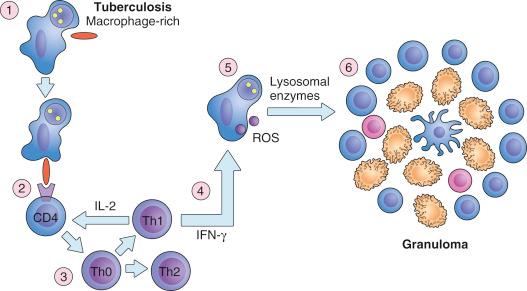Physical Address
304 North Cardinal St.
Dorchester Center, MA 02124
Granulomas consist of activated macrophages (epithelioid macrophages) accompanied by T lymphocytes and other immune cells, which infiltrate liver tissue as nodular lesions in reaction to indigestible or foreign antigen or are due to triggering of an untoward immunologic reaction (e.g., drug-induced liver injury [DILI]).
The major causes of hepatic granulomas include infectious agents (especially tuberculosis), sarcoidosis, primary biliary cholangitis (PBC), drugs, systemic diseases (e.g., Crohn disease), and neoplasms (e.g., Hodgkin lymphoma).
An elevated serum alkaline phosphatase level is the chief abnormality in serum liver biochemical tests.
The cause of hepatic granulomas may remain unknown in up to 50% of cases.
The workup for hepatic granulomas includes a complete history of therapeutic drugs, tests for antimitochondrial antibodies and angiotensin converting enzyme (ACE), and staining liver specimens with acid-fast and silver stains for mycobacteria and fungi, respectively.
Granulomas are rounded 1- to 2-mm nodular collections of activated macrophages, T lymphocytes, and other immune cells that can infiltrate many tissues, including the liver, in response to an indigestible or foreign antigen or as a manifestation of an untoward immunologic response to a drug, bile duct injury (e.g., PBC), or other factors ( Fig. 28.1 ).
![Fig. 28.1, Histopathology of a noncaseating hepatic granuloma (sarcoidosis). Epithelioid macrophages occupy the center of the granulomas with peripherally dispersed lymphocytes (hematoxylin and eosin [H&E]). Fig. 28.1, Histopathology of a noncaseating hepatic granuloma (sarcoidosis). Epithelioid macrophages occupy the center of the granulomas with peripherally dispersed lymphocytes (hematoxylin and eosin [H&E]).](https://storage.googleapis.com/dl.dentistrykey.com/clinical/GranulomatousLiverDisease/0_3s20B9780323478748000286.jpg)
The principal immune cells in granulomas are activated macrophages resembling epithelial cells (epithelioid macrophages); CD4+ T cells (T helper [Th] lymphocytes); and sometimes multinucleated giant cells that develop from macrophage fusion.
The cause of the granuloma influences the constituent immune cells and secreted products: type 1 T helper (Th1) cells and cytokines predominate in mycobacterial granulomas, whereas type 2 T helper (Th2) cells and cytokines predominate in schistosomal granulomas ( Fig. 28.2 ).
![Fig. 28.2, Generalized and specialized structural and functional characteristics of hepatic granulomas. The cellular constituents of hepatic granulomas are diagrammed at the bottom. Note that tuberculosis macrophage-rich granulomas show a type 1 T helper (Th1)–predominant lymphocytic response, with release of Th1 cytokines. In schistosomiasis, in contrast, enhanced numbers of eosinophils are present within the granulomas (mediated by secretion of interleukin 5 [IL-5]). In addition, release of IL-13 in schistosomiasis is an important factor resulting in portal fibrosis in the disease. IFN-γ, Interferon-gamma; iNOS, inducible nitric oxide synthetase; TNF-α, tumor necrosis factor alpha. Fig. 28.2, Generalized and specialized structural and functional characteristics of hepatic granulomas. The cellular constituents of hepatic granulomas are diagrammed at the bottom. Note that tuberculosis macrophage-rich granulomas show a type 1 T helper (Th1)–predominant lymphocytic response, with release of Th1 cytokines. In schistosomiasis, in contrast, enhanced numbers of eosinophils are present within the granulomas (mediated by secretion of interleukin 5 [IL-5]). In addition, release of IL-13 in schistosomiasis is an important factor resulting in portal fibrosis in the disease. IFN-γ, Interferon-gamma; iNOS, inducible nitric oxide synthetase; TNF-α, tumor necrosis factor alpha.](https://storage.googleapis.com/dl.dentistrykey.com/clinical/GranulomatousLiverDisease/1_3s20B9780323478748000286.jpg)
Granulomas evolve by the elaboration of secretory products (cytokines and chemokines) by their constituent cells (interferon-gamma and interleukin-2 from Th lymphocytes), expansion of macrophage and T-cell pools, and specialization of macrophages for antigen digestion ( Fig. 28.3 ).

Granulomas ultimately may persist, resolve, or undergo fibrosis or calcification.
Several types of granulomas are described in liver disease and are based on their histologic features and constituents ( Table 28.1 ). The presence of abundant eosinophils within granulomas warrants exclusion of DILI and parasite infestation.
| Type | Histologic Features | Cause(s) |
|---|---|---|
| Caseating | Peripheral macrophages ± giant cells; central necrosis | Tuberculosis |
| Noncaseating | Cluster of macrophages ± giant cells | Sarcoidosis Drugs |
| Lipogranuloma | Lipid vacuole(s) surrounded by macrophages and lymphocytes | Fatty liver Mineral oil |
| Fibrin-ring (doughnut granuloma) | Central lipid vacuole or empty space Macrophages and lymphocytes Ring of fibrin |
Q fever Allopurinol Hodgkin lymphoma |
Granulomas are found in 2.4% to 14.6% of liver biopsy specimens, according to surveys by and , although the figure of 10% is often quoted.
Granulomas are found in any of the following microscopic sites in the liver, alone or in combination:
Lobular (tuberculosis, sarcoidosis, drugs)
Portal/periportal (sarcoidosis)
Periductal (PBC)
Perivenous (mineral oil lipogranulomas)
Periarterial and intraarterial (phenytoin)
The etiology is multifactorial; the major causes and examples are shown in Table 28.2 .
| Etiology | Specific Cause(s) |
|---|---|
| Infection | Viral: Cytomegalovirus, infectious mononucleosis, hepatitis C virus infection Bacterial: Brucellosis, tuberculosis Rickettsial: Q fever Spirochetal: Treponema pallidum infection Fungal: Histoplasmosis Parasitic: Schistosomiasis |
| Primary biliary cholangitis | Early stages most commonly |
| Foreign body | Suture, talc |
| Systemic disease | Sarcoidosis, Crohn disease |
| Drug | Allopurinol, phenytoin, penicillin |
| Neoplasia | Hodgkin lymphoma |
Become a Clinical Tree membership for Full access and enjoy Unlimited articles
If you are a member. Log in here